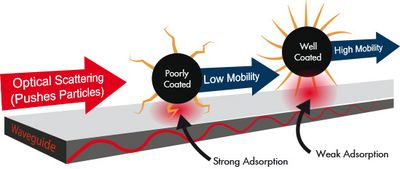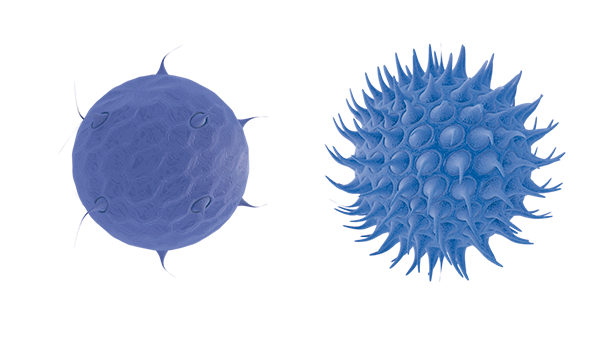Particle surface analysis: Near field light scattering to analyze nanoparticle coatings

Principle of the NanoTweezer: Nanoparticles trapped in the evanscent field of a waveguide scatter light. The intensity of the light and the mobility of the particle strongly depend on the distance waveguide particle, hence on the coating quality of the particle.
As a particle’s size decreases, the importance of its surface properties increase. At nanoparticle scales, much of their overall behavior is determined by surface properties, yet there are virtually no techniques that can accurately measure the state of a particle’s surface. Whether a new batch of particles will aggregate after two weeks, stick to a glass container surface, enter an epithelial cell, wind up at a tumor site, or accumulate a layer of proteins on its exterior, all depends on the particles’ surface properties. The increased use of nanoparticles and their application in fields such as medicine, electronics, batteries, and household products creates an even greater need for an improved method of analysis.
To yield nanoparticle dispersions with both chemical and colloidal stability, a thorough evaluation of these surface properties is essential.

Potential wells can be determined from the intensity histograms of each particle. Surface energy plots can be extracted by removing the optical component of the potential well. In this particular case, the particle require comparatively little energy to get to about 80 nm from the surface (red arrow). After this point, much more energy is required to “push” the particle closer.
An improved method to analyze nanoparticle surfaces and learn about interfacial forces has been revolutionized by the NanoTweezer. The main concept is simple, and the system answers one question: How much energy does it take to push a nanoparticle down onto a surface? Well-stabilized particles repel each other (otherwise they would aggregate). They also repel from any surface that mimics their own. These particles will be difficult to push down onto such a surface. Poorly stabilized particles, on the other hand, are easier to push. The same concept holds true for any particle surface interaction: hydrophilic, steric, electrostatic, etc.

NanoTweezer uses the unique waveguide-based technology commercialized by Optofluidics. This novel technology uses a laser to push particles along the surface of a waveguide and measures surface interactions between the particle and the waveguide. The waveguide surface can be engineered with special coatings, depending on what surface interaction is important.
More information on Nanotweezer



